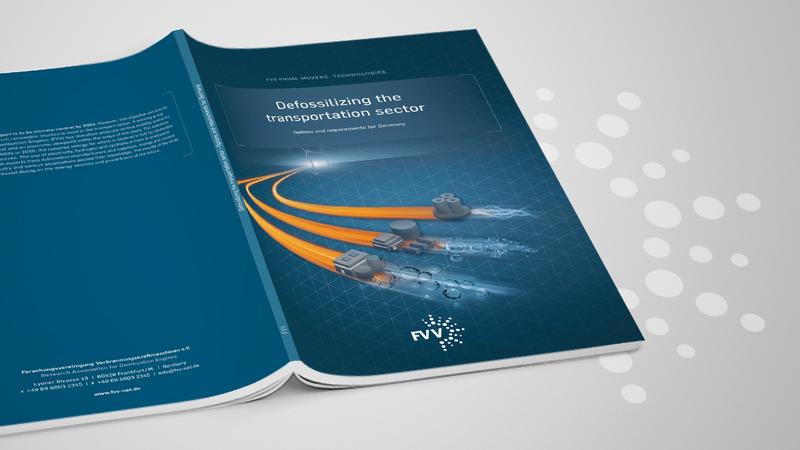On the road to climate-neutral driving
If transportation is to become completely climate-neutral by 2050, the costs for drivers are likely to rise. However, it doesn't make much difference whether a mid-range passenger car has a battery electric drive, a fuel cell or a combustion engine powered by electric fuels on board. This is the result of a comprehensive study in which the Research Association for Internal Combustion Engines (FVV) investigated the technical and economic options for climate-neutral transport.
» We would like to enable with this study a fact-based dialogue on future options for climate-neutral road transport," says FVV Managing Director Dietmar Goericke. "The course must be set in the coming years if we want to achieve our climate targets by 2050. «
In order to achieve the goals of the Paris Climate Protection Agreement, road transport must become largely climate-neutral by 2050. It is not enough just to look at the carbon dioxide (CO2) emitted by road vehicles. Rather, the entire chain from the generation of electricity to the production of the energy source to the driven wheel in the vehicle must be analyzed. This is exactly what a cross-industry expert group of the FVV under the leadership of Dr. Ulrich Kramer, Ford-Werke GmbH, has done. At times, more than 40 experts from various industries belonged to it. The study "Defossilizing the transportation sector" examines the generation, distribution and use for three combinations of powertrain system and energy source: firstly, the direct use of electricity in battery electric powertrains; secondly, hydrogen production by electrolysis and its use in a fuel cell; and thirdly, the use of climate-neutral liquid or gaseous fuels in internal combustion engines. For each path, the minimum and maximum costs were calculated in detail by engineers and scientists on the basis of the underlying production processes.
The starting point of the study is the mechanical energy demand actually required for mobility in Germany in order to provide today's transport services - including road freight transport. The experts estimate this demand at 143 terawatt hours (TW h). In a scenario in which all cars are battery-powered and trucks on motorways are supplied with electricity by overhead lines, between 249 and 325 TW h of additional electricity would have to be generated. This corresponds to about half of Germany’s current consumption of electrical energy. The additional electricity required could, for example, be generated by installing 10,000 to 15,000 new offshore wind turbines of the 5 megawatt class. In the scenario based on hydrogen and fuel cells, the minimum and maximum values differ more clearly. In the best case, 502 TW h of additional electricity would have to be generated by central electrolysis. If the hydrogen is produced locally at the filling stations, this value can rise to up to 703 TW h. The energy balance of electric fuels depends on which of the many possible production paths and starting materials is used. Of the eight powertrain/fuel combinations investigated, e-methane scores best. If the carbon dioxide required for the process is obtained from the exhaust gases of industrial plants, the electricity requirement is a minimum of 625 TW h. The value can more than double if a more complex liquid fuel produced in a more complicated, multi-stage process is used and the carbon dioxide is removed from the air.
Nevertheless, the mobility costs* calculated in the study differ only slightly. A passenger car powered by e-methane achieves the lowest value with 28.4 cents per kilometre. Battery electric cars and fuel cell vehicles follow closely behind at 29.4 and 29.9 cents per kilometer, respectively. The study also shows that mobility costs are dominated by vehicle purchase costs. The scenarios differ considerably with regard to the investment requirements necessary for the economy as a whole for the provision of renewable energy, the fuel generation plants, the infrastructure development and the additional costs of the vehicle fleet accumulated over 20 years compared with the basic vehicle powered by an SI engine. It fluctuates between just under 300 and around 1,700 billion euros. Here, too, the additional vehicle costs accumulated over 20 years account for a significantly higher proportion than the investments in the infrastructure for electricity and fuel production.
In addition to the technical and economic options for climate-neutral energy chains, the FVV study provides a large number of other results. For example, the risks associated with the distribution and use of new fuels in vehicles were analysed in detail. The result: Although each technology path has specific risks, all the paths examined are technically controllable. Finally, the experts identify the research needs that still exist in the production of energy sources, energy supply as well as vehicle and propulsion technologies. For the efficient production of alternative energy sources, it is therefore particularly important to improve the efficiency during dynamic plant operation. Further optimisation of the efficiency under real operating conditions is also an important field of research for powertrain systems. A special feature of some of the e-fuels investigated is their admixture with fossil fuels, which can directly reduce the climate balance of existing vehicles. Here, too, the experts recommend intensified research funding.
* The mobility costs considered in the study consist of the loss in value of a vehicle in the lower middle class over four years with an annual mileage of 15,000 km as well as the untaxed fuel/energy costs and the cost of setting up the infrastructure.
Wissenschaftlicher Ansprechpartner:
Dietmar Goericke, FVV Managing Director, +49 69 6603-1821, goericke@fvv-net.de
Originalpublikation:
https://www.fvv-net.de/fileadmin/user_upload/medien/materialien/FVV__Future_Fuels__Study_report__Defossilizing_the_transportation_sector__R586_final_2018-09-01__EN.pdf
Die semantisch ähnlichsten Pressemitteilungen im idw


